Samsung SSD XP941 Review: The PCIe Era Is Here
by Kristian Vättö on May 15, 2014 12:00 PM ESTMac Benchmarks: QuickBench, AJA & Photoshop Installation
Since the XP941 is currently only bootable in Macs, I decided to run some benchmarks with the XP941 inside a Mac Pro. The specs of the Mac Pro are as follows:
| Test Setup | |
| Model | Mac Pro 4.1 (Early 2009) |
| Processor | Intel Xeon W3520 (2.66/2.93GHz, 4/8, 8MB L3) |
| Graphics | NVIDIA GeForce GT120 512MB GDDR3 |
| RAM | 12GB (2x4GB + 2x2GB) DDR3-1066 ECC |
| OS | OS X 10.9.2 |
We would like to thank RamCity for providing us with the Mac Pro, so we were able to run these tests and confirm boot support.
I installed OS X 10.9.2 to all drives and they were the boot drives when benchmarked, just like they would be for most end users. As I mentioned on page one, RamCity actually sent us two 512GB XP941 and I just had to put them in RAID 0 configuration. With a Mac you can easily boot from a software RAID 0 array, so all I had to do was to create a RAID 0 array in Disk Utility and select it as the boot volume. I placed the drives in PCIe slots 2 and 4 to ensure that both drives were getting full PCIe bandwidth and we wouldn't run into bottlenecks there. I picked Intel's 480GB SSD 730 to be the comparison point as it was lying on my table and is among the fastest SATA 6Gbps SSDs in the market. Note that the 2009 Mac Pro only supports SATA 3Gbps, so there's obviously some performance penalty from that as the benchmarks show.
QuickBench
QuickBench is one of the more sophisticated drive benchmark tools for OS X. It's shareware and retails for $15 but compared to the freeware tools available, it's worth it. While QuickBench lacks the option to increase queue depth, it supports various transfer sizes from 4KB to up to 100MB (or more through a custom test). For this test, I just ran the standard test where the IO sizes range from 4KB to xMB. Additionally I ran the extended test, which focuses on very large IOs (20-100MB) in order to get the maximum performance out of the drives. In both cases the tests ran for 10 cycles to ensure sustained results.
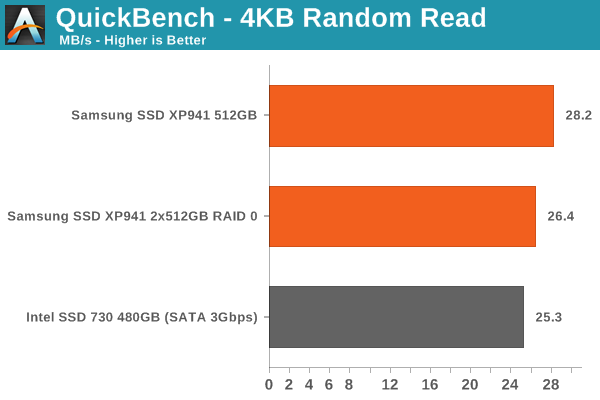
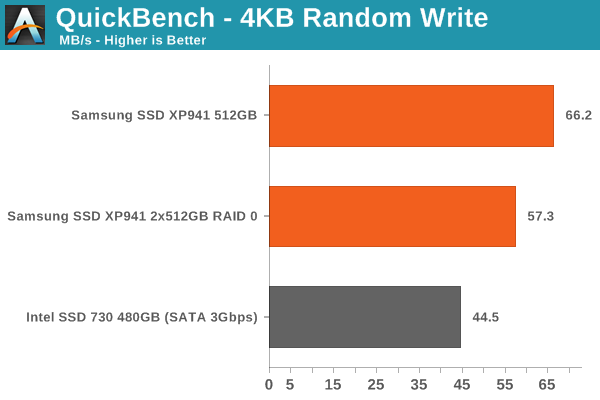
The random results don't reveal anything interesting. The RAID 0 array is slightly slower due to the overhead from the software RAID configuration but overall the results make sense when compared with our Iometer scores. Bear in mind that QuickBench only uses queue depth of 1, whereas our Iometer tests are run at queue depth of 3, hence there's a difference that is roughly proportional to the queue depth.
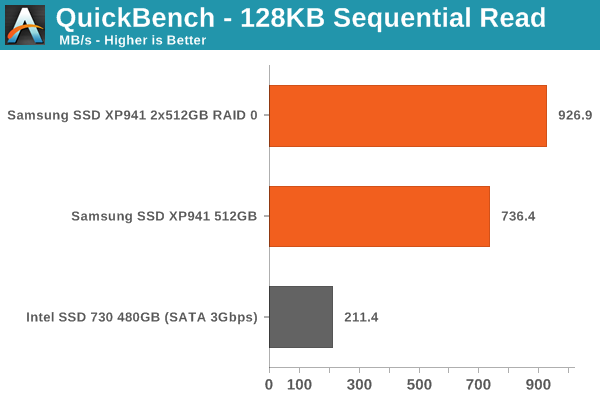
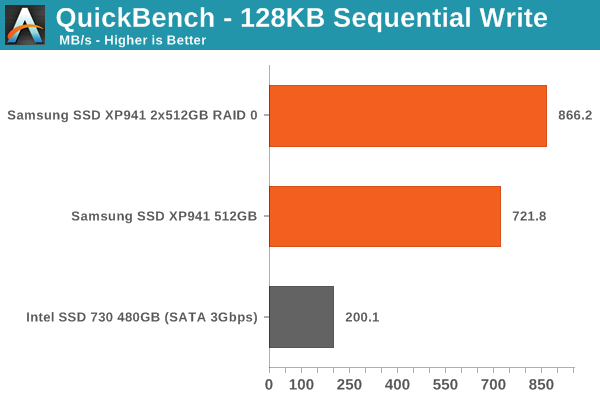
The sequential tests show that the XP941 seems to be slightly slower in the Mac Pro compared to sequential performance in Iometer. In this case both tests are at a queue depth of 1 and should thus be comparable, but it's certainly possible that there are some other differences that cause the slightly slower performance. Either way, we are still looking at much, much higher performance than any drive would provide under the Mac Pro's native SATA 3Gbps interface.
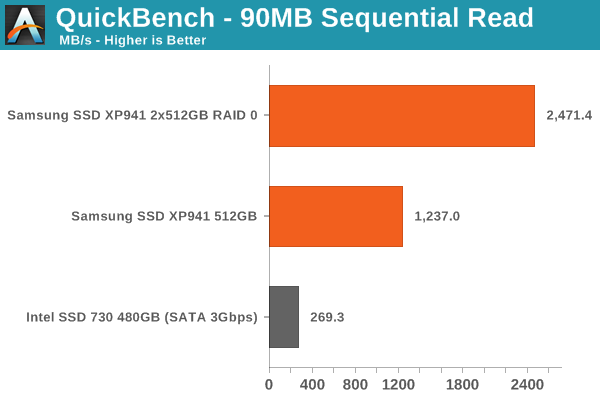
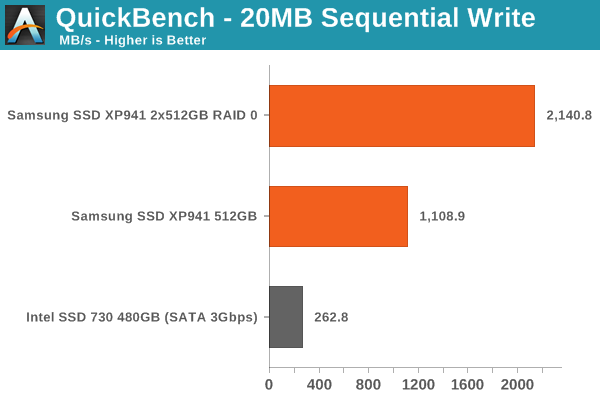
Since QuickBench doesn't allow increasing the queue depth, the only way to increase performance is to scale the transfer size. QuickBench's preset tests allow for up to 100MB IO sizes and I ran the preset that tests from 20MB to 100MB and picked the highest perfoming IO sizes that were 90MB and 20MB in this case. There wasn't all that much variation but these seemed to be the highest performing IO sizes for all three configurations.
Now the XP941 and especially RAID 0 show their teeth. With two XP941s in RAID 0, I was able to reach throughput of nearly 2.5GB/s (!) and half of that with a single drive. Compared to the SSD 730 in the SATA 3Gbps bus, you are getting over four times the performance and to reach the performance of X941 RAID 0 you would need at least ten SSDs in a SATA 3Gbps RAID 0 configuration.
AJA System Test
In addition to QuickBench, I decided to run AJA System Test as it's a freeware tool and quite widely used to test disk performance. It's mainly designed to test the performance of video throughput but as the results are reported in megabytes per second, it works for general IO testing as well. I set the settings to the maximum (4096x2160 10-bit RGB, 16GB file size) to product the results below.
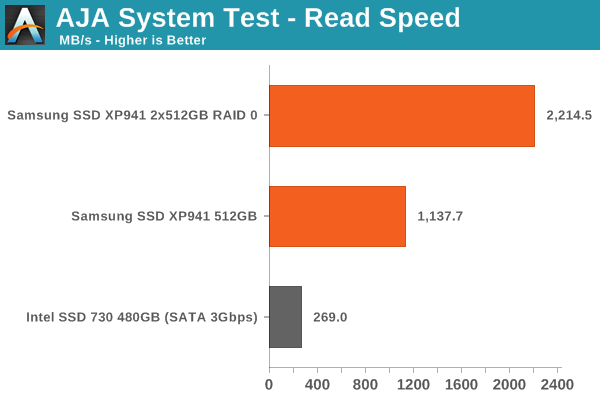
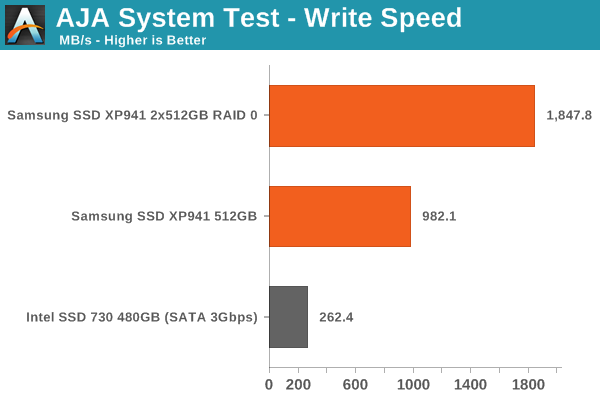
The results are fairly similar to the QuickBench ones but the performance seems to be slightly lower. Then again, this is likely due to the difference in the data the software uses for testing but the speeds are still well over 1GB/s for a single drive and 2GB/s for RAID 0.
Adobe Photoshop CS6 Installation
One of the most common criticism I hear towards our tests is that we don't run any real world tests. I've been playing around with real-time testing a lot lately in order to build a suite of benchmarks that meet our criteria but for this review I decided to run a quick installation benchmark to see what kind of differences can be expected in real world. I grabbed the latest version of Photoshop CS6 trial from Adobe's website and installed it to all three drives while measuring the time with a stopwatch.
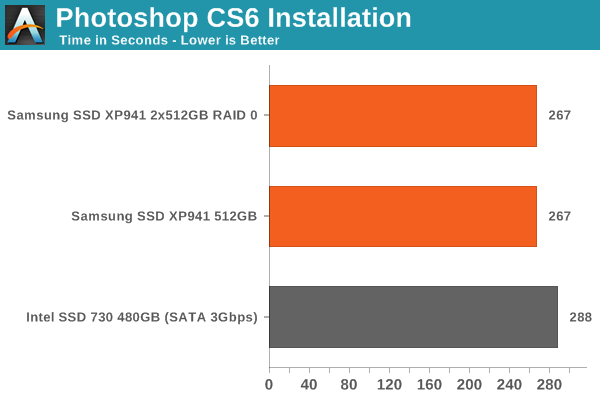
Obviously the gains are much smaller in typical real world applications. That's because other bottlenecks come to play, which are absent when only testing IO performance. Still, especially for IO heavy workloads the extra performance is always appreciated even if the gains aren't as substantial as benchmarks show.










110 Comments
View All Comments
BMNify - Thursday, May 15, 2014 - link
"They still do[es] not have one for PCIe-based Macs"so, just get the pci-e card above and use that or even a generic pcie to pci converter and you can install them in your PPC mac, and other systems too, weather they would be accessible booting anything other than a linux PPC distro is another matter OC
Penti - Thursday, May 15, 2014 - link
Macs with PCIe-based SSD's, obviously you could run a discrete PCIe-card (SSD) in a Mac Pro (but that would be SATA/RAID-based not PCIe). PCIe AHCI-based SSD's are only available directly from Apple and made by Samsung and Sandisk, and is only used in recent MBAir, MBP 13/15 and new Mac Pro as well as recent iMacs. There are no third party solutions yet. For previous generations there are solutions and before their own SATA-card SSD they used 2.5-inch drives everywhere except in the Airs. For the 2008/2009 MBA with 1.8-inch drives there are solutions available too. At PowerPC based macs you have either SATA or IDE natively. They just haven't figured out how to produce a PCIe-based SSD for the Macs yet. Over at OWC or anywhere else.RamCity - Thursday, May 15, 2014 - link
Just in case this part was missed in the review here, the XP941 is widely compatible (when installed with an adapter) in the pre-2013 Mac Pro's - all the way back to the 2006/2007 models. The Barefeats.com review is worth a look if you want more information.http://barefeats.com/hard183.html
Penti - Friday, May 16, 2014 - link
The thing I was referring too is that it's not compatible and neither has any compatible modules been made yet for the PCIe-based SSD's of the newer Macs. While earlier SATA-based Apple-custom cards had third party solutions that worked. XP941 is obviously used with a early 2009 Mac Pro with boot-support in the review. So we have number right here. PPC-based systems wouldn't boot it however, even if you might get a Linux-system to recognize it. Which is so far off topic that it's incredible.Penti - Friday, May 16, 2014 - link
Obviously when they have figured out the new connector from Apple the PCIe based controllers should run fine over there on third party cards. Now they just don't exist yet. Like for the thread starters MacBook Pro.Penti - Friday, May 16, 2014 - link
And a early 2013 MBP with SATA-based SSD can use after market SSD's, but not the ones with PCIe yet.Hrel - Thursday, May 15, 2014 - link
256GB SSD, about $100. This one is over $300. Increased speed is nice, but it doesn't matter until they can do it at a better price, closer to the SATA prices the better.I'd be willing to be an early adopter at $200, but I couldn't recommend it to most people until it dropped to $100. I've only recently been able to start recommending SATA SSD's to normal people who don't obsess over every new computer tech.
MrSpadge - Thursday, May 15, 2014 - link
Yeah.. at 3 times the price you'd be far better off using 2 or 3 regular SSDs in RAID - unless you don't have the space and SATA slots for that, like in a mobile workstation.Babar Javied - Thursday, May 15, 2014 - link
Remember when SSDs first came out? they were expensive. But they steadily came down in price and I am sure this will too in due time. Keep in mind that this is new tech and bond to be expensive at first... hell, there is isn't even proper support for it yet.JoyTech - Thursday, May 15, 2014 - link
The benchmark tests only lists results for 512 GB version of Samsung SSD XP941. Are the results same for 256 GB and 128 GB? It is really confusing that this article and previous ones, don't provide those results!